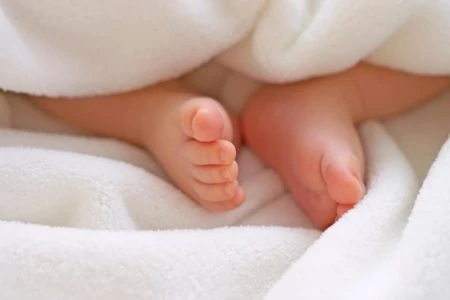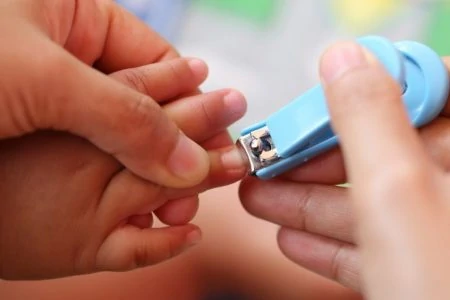Spotting a red or swollen toe on your baby can set off immediate alarm bells. Is it an infection? Did they hurt themselves? While it looks painful, you are likely dealing with a common ingrown toenail.
These pesky nail issues happen frequently with infants. The good news is that they are generally harmless if caught early. With the right home care and a watchful eye for infection, you can get those little feet back to normal quickly.
We are here to walk you through everything you need to know about baby ingrown toenails. From identifying the subtle signs to safe home remedies and prevention tips, we will help you keep your baby’s toes happy and healthy.
Key Takeaways
- What it is: Ingrown toenails happen when the nail edge grows into the soft surrounding skin, causing redness and swelling.
- Common causes: Tight socks, shoes, or footie pajamas, along with improper nail trimming, are the main culprits.
- Treatment: Warm soapy water soaks and gentle massage usually resolve the issue; avoid digging out the nail.
- Prevention: Always cut toenails straight across rather than rounding the corners, and keep footwear loose.
What Are Ingrown Toenails?
Ingrown toenails, medically known as onychocryptosis, occur when the side or corner of a toenail grows into the soft flesh next to it. This causes pain, redness, and swelling. While it can happen to any toe, the big toe is the most common victim (1).
In babies, the skin surrounding the nail is naturally soft, and the nails are often curved, creating the perfect storm for this condition.
Does My Baby Have an Ingrown Toenail?
Newborns often have soft, triangular nails that may look like they are digging into the skin. This is frequently a condition called “pseudo-ingrown toenails.” The skin around the nail appears raised or swollen, but the baby feels no pain and there is no infection. In these cases, the nails usually grow out and correct themselves without intervention.
However, a true ingrown nail causes discomfort. Since your baby cannot tell you their toe hurts, you have to play detective.
Look for these common symptoms:
- Localized redness: The skin right next to the nail edge will look pinker or redder than the rest of the toe.
- Swelling and tenderness: The area may look puffy. If your baby cries or pulls away when you gently touch the toe or put on socks, it is likely tender.
- Behavioral changes: An older baby might limp, refuse to crawl, or cry during bath time when you wash their feet.
- Pulling at feet: While babies love grabbing their feet, frantic pulling accompanied by fussiness can indicate pain.
If the nail becomes infected (paronychia), the symptoms will escalate. Watch for:
- Blisters: Fluid-filled bumps may form where the nail meets the skin.
- Discharge: You might see white or yellow pus, or clear fluid weeping from the area.
- Heat and spreading redness: The toe may feel warm to the touch, and the redness might spread further down the toe.
What Causes Ingrown Nails?
Understanding the cause helps you prevent future occurrences. Several factors contribute to this painful problem.
- Rapid growth: Baby nails grow surprisingly fast. If the nail gets too long, it can curl and dig into the skin.
- Tight footwear: This is a major culprit. Tight socks, rigid shoes, or even footie pajamas that are too small can compress the toes, forcing the nail to grow inward.
- Trimming habits: Cutting nails too short or rounding the edges encourages the nail to grow sideways into the skin rather than straight out.
- Genetics: Some babies are simply born with naturally curved nails that are more prone to becoming ingrown.
Treatments for Ingrown Toenails
If there are no severe signs of infection like pus or fever, you can treat the issue at home. The goal is to soften the skin and encourage the nail to grow over the skin rather than into it.
Follow these steps for home relief:
- The warm soak: Fill a small tub or basin with warm, soapy water. Let your baby’s foot soak for about 10 to 20 minutes. This softens the nail and skin while reducing swelling. Do this twice a day.
- Gentle massage: While the skin is soft from the bath, gently massage the skin away from the nail. This helps release the buried edge.
- Antibiotic cream: After drying the foot thoroughly, you can apply a small amount of over-the-counter antibiotic ointment to prevent infection and speed up healing. Consult your pediatrician before using medication on newborns.
- Let them breathe: Keep socks and shoes off as much as possible while the toe heals. Fresh air helps keep the area dry and reduces pressure.
Important: Never try “bathroom surgery.” Do not attempt to dig the nail out, cut into the skin, or use dental floss to lift the nail unless specifically instructed by a doctor. This often worsens the pain and increases the risk of serious infection.
How to Prevent Ingrown Toenails
Prevention is largely about how you groom those tiny toes and what you put on their feet.
- Cut straight across: This is the golden rule. When using nail clippers, trim the toenail straight. Do not round off the corners, as this guides the nail into the skin as it grows.
- File sharp edges: If cutting straight across leaves a sharp corner, use a baby emery board to gently smooth the very tip, but do not file down the side of the nail.
- Frequent checks: Check toenails weekly. They grow slower than fingernails but still need regular maintenance.
- Check the fit: Ensure socks, shoes, and sleeper suits have plenty of wiggle room. If the fabric pulls tight against the toes, it is time to size up. Loose-fitting socks are best.
- Go barefoot: When indoors and safe to do so, letting your baby go barefoot aids in proper foot development and keeps pressure off the nails.
When Should I Contact the Pediatrician?
Most ingrown toenails resolve with home treatment within a few days. However, you should call your doctor if:
- No improvement: The redness and swelling persist after 3 to 4 days of home care.
- Signs of infection: You see pus, a blister, or the redness starts streaking up the toe or foot.
- Fever: Your baby develops a fever alongside the toe issue.
- Recurrence: The problem keeps coming back despite proper trimming.
In persistent cases, a doctor may need to remove a small portion of the nail. In rare, chronic situations, they might refer your baby to a pediatric podiatrist.






